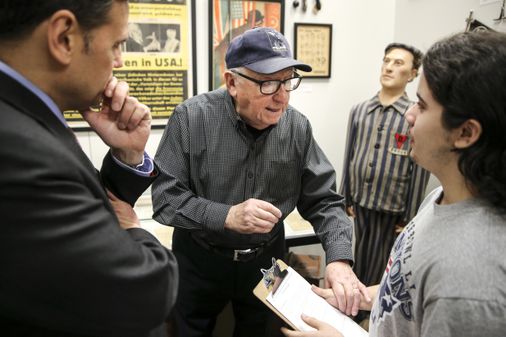The thousands of purchased artifacts, owned by Rendell and his wife, Shirley McNerney Rendell, range from a Sherman tank and a Higgins landing boat to Hitler’s uniform and mustache trimmer. They made up more than 65 percent of the museum’s collection, Rendell estimated.
The future of the collection is now unclear. In a written statement Monday evening, a representative for Lauder wrote: “While it has not yet been decided where each object will be on display, Ambassador Lauder wants to make sure that the objects find a home that attracts an even bigger audience than where the objects are currently on display.”
Lauder, who served as ambassador to Austria under President Ronald Reagan, “has dedicated much of his life to educating the world about the atrocities that occurred during World War II,” the statement noted. “The objects in this collection . . . must be used to tell the story of the War and ensure such a crime on humanity never occurs again.”
Meanwhile, the museum board is considering what to do with the remaining artifacts. “There isn’t a coherent enough group [of exhibits] for the museum to continue operating,” Rendell said. The exhibits may be transferred to another World War II organization that is planning to create a museum elsewhere in New England, he added.
In 2017, Rendell launched an unsuccessful campaign for a new building in Natick with triple the exhibition space of the current one. “We just never were able to raise significant money in Boston,” he said, noting that most of the potential donors were from outside New England and opposed to a Boston site.
After completing the purchase of the collection at the end of 2018, Lauder signed an agreement to lease it to the museum until at least the end of this year. The pact included a clause allowing either party to back out with 30 days’ notice — a provision Rendell called standard, boilerplate language for museum loans.
In April, Lauder’s lawyers surprised the museum by giving notice that the New York philanthropist, in fact, wanted to back out of the agreement to let the museum lease the exhibit through the end of the year — and take possession of it sooner.
They said removal of the artifacts would be delayed until July to allow the museum to go ahead with a special 75th anniversary D-Day exhibit and to accommodate student groups for that school year. The museum countered that it needed to remain open until early December, citing school groups scheduled through fall, an ongoing digital project with PBS, and the logistical challenges of literally having to raise the roof to remove large objects such as tanks, among other reasons.
In July, Lauder — acting through a holding company, Ellenville LLC — filed suit against the museum. His lawyers argued that waiting until December in effect negated the termination clause. That filing was the first public disclosure that Lauder had purchased the collection.
Uncertain over the outcome of the lawsuit, the museum decided to shut its doors last week. “We had groups booked to come, and we do not know what’s going to happen,” Rendell said. “We couldn’t keep things going week to week.”
In court filings, Lauder’s lawyers have not indicated why they sought to terminate the lease, beyond saying they wanted the artifacts moved to a separate storage site to be inventoried.
Nothing in either the sales contract or the lease agreement specifies continued cooperation between the museum and Lauder.
In a declaration filed with the court, Susan Farrington, executive assistant to Rendell, said that until receiving Lauder’s early termination notice, the museum had assumed that the plan to remain in Natick until relocating to Washington “was moving forward.
She noted that she had set up “dozens of meetings” between Rendell and Lauder in New York; had arranged for Rendell to travel to London to meet with a firm approved by Lauder to design the interior of the new building in Washington; and had coordinated meetings to select potential architects for the building’s exterior.
Rendell said that he last met with Lauder late last year and has not been in direct communication with him since. “Lauder is a very smart, sensitive guy,” Rendell said. “In all of our meetings his understanding and foresight were very impressive.”
Rendell said it was necessary to sell the collection because no one would put up money for a new museum without control of its exhibits. “Keeping it all together was an extremely important factor here,” he said.
Since the lawsuit was filed against the museum and not him, Rendell declined to comment directly on it.
Of Lauder, he said, “I have no idea what his intentions are now, but I certainly knew what they were.”
Asked if he regretted not putting the collection’s future in writing, Rendell said, “I’ve been in business for more than 60 years. It’s been extremely rare for me to put an agreement in writing. There hasn’t been a necessity to do it. I haven’t lived in a world in which that was necessary.”
Rendell said he first began collecting World War II memorabilia in 1960. At first, he said, “it was really small stuff — $10 here and $10 there — because I didn’t have any money.” Until the 1970s, much of what he purchased came from estate sales.
Among the materials he amassed are more than 100 uniforms and vintage outfits, 725 World War II maps; 1,650 war posters; a variety of weaponry; and 500,000 photographs.
Lauder, 75, is an heir to the Estée Lauder Cos. Head of the World Jewish Congress, he has been active in legal battles to recover Jewish-owned artworks stolen or forcibly sold during the Nazi era. He helped establish the Neue Galerie, a New York museum specializing in early 20th century German and Austrian art.
Rendell, 76, made a career dealing in historical documents and letters. He is the author of eight books, many related to World War II. Most famously, in 1983, he was hired by Newsweek and Stern magazines to aid in exposing the fake Hitler diaries.
The Natick museum billed itself as the most comprehensive in the world for its displays that cover all theaters of combat and provide the perspectives of ordinary soldiers and their leaders; the persecuted and the persecutors; and the civilians back home.
The museum was only open a couple of days a week to the public. Other days were for school groups. “Last year we had 4,000 students and 40 percent were subsidized by us,” Rendell said. “We had 1,000 students on the waitlist.”
Steve Maas can be reached at [email protected].


















